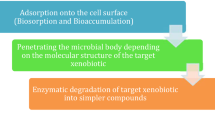Abstract
The effect of the pesticide Lindane on microbial populations was analyzed in soil with a history of contamination with various chemicals, including this pesticide. Soil microcosms were amended with 100 mg Lindane/kg soil and microbial populations were monitored for 70 days. Bacterial cell concentrations, metabolic versatility (whole community Biolog), and genetic diversity (16S rDNA/denaturing gradient gel electrophoresis) were used to monitor microbial communities. Results show the persistence of Lindane in the soil environment; at the end of the experiment, 70% of the added Lindane remained undegraded. A reduction of 50% in bacterial cell concentration was observed in Lindane-amended microcosms during the 2nd week of the experiment. This reduction was correlated with a reduction in the rate of substrate utilization as observed by Biolog. Overall, no effect of Lindane was observed on the metabolic versatility and genetic diversity in these soils, demonstrating the ability of these bacterial populations to tolerate the pressure caused by the addition of pesticides.





Similar content being viewed by others
References
Atlas R (1986) Microbial diversity. Adv Microb Ecol 5:1–25
Bloem J, Blhuis P, Veninga M, Wieringa J (1998). Microscopic methods for counting bacteria and fungi in soil. In: Alef K, Nannipieri P (eds) Methods in applied soil microbiology and biochemistry. Academic Press, New York
Engelen B, Meinken K, von Wintzingerode F, Heuer H, Malkomes HP, Backhaus H (1998) Monitoring impact of a pesticide treatment on bacterial soil communities by metabolic and genetic fingerprinting in addition to conventional testing procedures. Appl Environ Microbiol 64:2814–2821
Fantroussi SE, Verschuere L, Verstraete W, Top EM (1999) Effect of phenylurea herbicides on soil microbial communities estimated by analysis of 16S rRNA gene fingerprints and community-level physiological profiles. Appl Environ Microbiol 65:982–988
Garland JL (1996) Analytical approach to the characterization of samples of microbial communities using patterns of potential C source utilization. Soil Biol Biochem 28:213–221
Garland J (1997) Analysis and interpretation of community-level physiological profiles in microbial ecology. FEMS Microbiol Ecol 24:289–300
Garland JL, Mills AL (1991) Classification and characterization of heterotrophic microbial communities on the basis of patterns of community-level sole-carbon-source utilization. Appl Environ Microbiol 57:2351–2359
Gramatica P, Di Guardo A (2002) Screening of pesticides for environmental partitioning tendency. Chemosphere 47:947–956
Jagnow G, Haider K, Ellwardt PC (1977) Anaerobic dechlorination and degradation of hexachlorocyclohexane isomers by anaerobic and facultative anaerobic bacteria. Arch Microbiol 115:285–292
Johri AK, Dua M, Tuteja D, Saxena R, Saxena DM, Lal R (1996) Genetic manipulations of microorganisms for the degradation of hexachlorocyclohexane. FEMS Microbiol Rev 19:69–84
MacRea IC, Raghu K, Batista EM (1969) Anaerobic degradation of the insecticide lindane by Clostridium sp. Nature 221:859–860
McCaig AE, Glover LA, Prosser JI (2001) Numerical analysis of grassland bacterial community structure under different management regimens by using 16S ribosomal DNA sequence data and denaturing gradient gel electrophoresis banding patterns. Appl Environ Microbiol 67:4554–4559
Miyauchi K, Lee HS, Fukuda M, Takagi M, Nagata Y (2002) Cloning and characterization of linR, involved in regulation of the downstream pathway for gamma-hexachlorocyclohexane degradation in Sphingomonas paucimobilis UT26. Appl Environ Microbiol 68:1803–1807
Muller AK, Rasmussen LD, Sorensen SJ (2001) Adaptation of the bacterial community to mercury contamination. FEMS Microbiol Lett 204:49–53
Muyzer G, de Waal H, Uitterlinden A (1993) Profiling of complex microbial populations by denaturing gradient gel electrophoresis analysis of polymerase chain reaction-amplified genes coding for 16S rRNA. Appl Environ Microbiol 59:695–700
Myers RM, Maniatis T, Lerman LS (1987) Detection and localization of single base change by denaturing gradient gel electrophoresis. Methods Enzymol 155:501–527
Nagata Y, Ohtomo R, Miyauchi K, Fukuda M, Yano K, Takagi M (1994) Cloning and sequencing of a 2,5-dichloro 2,5-cyclohexadiene-1,4-diol dehydrogenase gene involved in the degradation of gamma-hexachlorocyclohexane in Pseudomonas paucimobilis. J Bacteriol 176:3117–3125
Nagata Y, Miyauchi K, Damborrsky J, Manovaa K, Ansorgova A, Takagi M (1997) Purification of a haloalkene dehalogenase of a new substrate class from a hexachlorocyclohexane-degrading bacterium, Sphingomonas paucimobilis UT26. Appl Environ Microbiol 63:3707–3710
Popp P, Bruggemann L, Keil P, Thuss U, Weiss H (2000) Chlorobenzenes and hexachlorocyclohexanes (HCHs) in the atmosphere of Bitterfeld and Leipzig (Germany). Chemosphere 41:849–855
Rasmussen LD, Sorensen SJ (2001) Effects of mercury contamination on the culturable heterotrophic, functional and genetic diversity of the bacterial community in soil. FEMS Microb Ecol 36:1–9
Sahu SK, Patnaik KK, Bhuyan S, Sethunathan N (1993) Degradation of soil-applied isomers of hexachlorocyclohexane by a Pseudomonas sp. Soil Biol Biochem 25:387–391
Sannino F, Gianfreda L (2001) Pesticide influence on soil enzymatic activities. Chemosphere 45:417–425
Tilman D (1996) Biodiversity: population versus ecosystem stability. Ecology 77:350–363
Torsvik V, Daae FL, Sandaa RA, Ovreas L (1998) Novel techniques for analyzing microbial diversity in natural and perturbed environments. J Biotechnol 64:53–62
Toyota K, Ritz K, Kuninaga S, Kimura M (1999) Impacts of fumigation with meta-sodium upon soil microbial community structure in two Japanese soils. Soil Sci Plant Nutr Soil 45:207–223
Vogel TM, Cérémonie-Farhane H, Siminet P (2001) Bioremediation of lindane—natural microorganisms, indigenous genes and bioaugmentation. In: Proceedings of 9th International Symposium on Microbial Ecology, Amsterdam, The Netherlands. 26–31 August 2001, TU.084abstract, p 148
Wünsche L, Brüggemann L, Babel W (1995) Determination of substrate utilization patterns of soil microbial communities: an approach to assess population changes after hydrocarbon pollution. FEMS Microbiol Ecol 17:295–306
Zhou J, Xia B, Treves DS, Wu LY, Marsh TL, O'Neill RV, Palumbo AV, Tiedje JM (2002) Spatial and resource factors influencing high microbial diversity in soil. Appl Environ Microbiol 68:326–334
Acknowledgements
We thank Johana Santamaria and Giomar Rivera for their comments on the manuscript. This project was funded by a grant from NASA-IRA and an RCMI grant to the University of Puerto Rico.
Author information
Authors and Affiliations
Corresponding author
Rights and permissions
About this article
Cite this article
Rodríguez, R.A., Toranzos, G.A. Stability of bacterial populations in tropical soil upon exposure to Lindane. Int Microbiol 6, 253–258 (2003). https://doi.org/10.1007/s10123-003-0137-9
Received:
Accepted:
Published:
Issue Date:
DOI: https://doi.org/10.1007/s10123-003-0137-9




